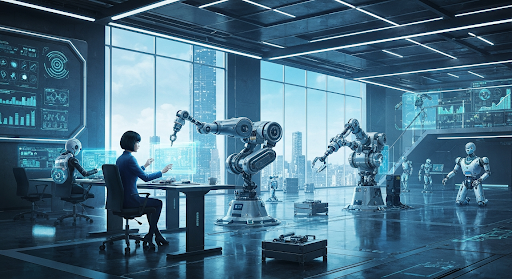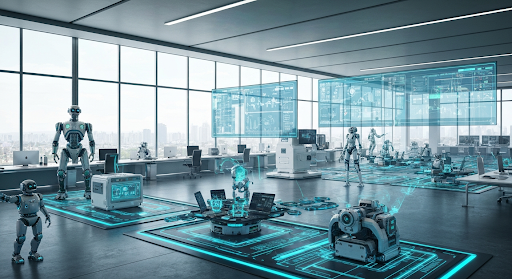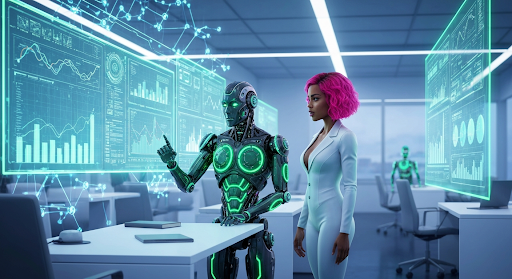How Robots Automation is Transforming Business Processes
Key Highlights
- Robotic automation is changing the way that business process automation works. It is making work smoother in many industries and helping people get their tasks done faster and in a better way.
- Automation technology takes over repetitive tasks. This lets human workers be free from doing manual labor and helps to make them more productive.
- Industrial robots and collaborative robots, also called cobots, are changing both how factories and office jobs work. They are making all kinds of physical processes run better.
- Smart software robots that use artificial intelligence let companies use process automation for more complex tasks.
- Robotic process automation (RPA) helps make sure that quality control and steadiness in workflows stay high
- The fast
use of automation technology is driving digital transformation and changing the way we work at our jobs.
Introduction
Robots and automation are changing how businesses work today. Robotic process automation helps companies make their tasks run smoother. This lets them be more effective and save money. With automation software, businesses can handle repetitive tasks and solve difficult problems. Because of new software solutions, these companies can now have smarter and more active business ways. Robot automation can take care of jobs like supply chains and data entry that used to need a lot of manual labor. This means people at work can spend their time on new ideas. In the next sections, we will look at how this big change is happening.
Understanding Robots Automation in Modern Business
Robots are now a key part of automation technology in today’s fast-changing business world. They do jobs with high accuracy and need very little human intervention. This helps companies automate work that used to take a lot of time and had many mistakes.
When you use process automation and robot automation in business process automation, it helps companies get more done and handle changes in the market faster. People use robots in both factories and offices. Robots give many benefits in these areas. They help lower costs, make work go smoother, and help people get better results. Now, let’s take a closer look at what some of these important ideas and terms in this growing trend mean.
Key Concepts and Definitions
Process automation is about using technology, like robots, to make tasks easier by taking care of the jobs that are repeated often. It does not only mean physical robots. There are also programmable machines and software robots that are important in industries such as manufacturing and finance.
Programmable machines, including industrial robots, are at the heart of making physical processes work faster, such as assembly or material handling. These machines use sensors and software to make sure things get done in the right way and can change when needed.
Industrial automation brings together robotics and computer science. This helps companies create systems that can handle tasks on their own. With things like artificial intelligence (AI) and machine learning, automation systems have grown. Now, robots can use data to make good choices. This leads to more efficiency and less need for human intervention. All of these new technologies are changing the way businesses take on everyday work.
The Evolution of Automation Technologies
Automation technology has changed a lot with time. It started out with basic mechanical tools, but now uses advanced systems that run on artificial intelligence and machine learning. In the beginning, the automation process was simple and always needed a lot of human intervention to watch and control what was going on.
New developments in artificial intelligence make it possible for systems to do complex tasks on their own. These modern robots do not just follow simple orders. They learn from their actions and change how they work while things are happening. This helps businesses stop using old systems and instead use models that can change, predict problems, and get better results. There are fewer mistakes, and the amount of work gets bigger.
Machine learning is an important part of making automation better. It lets robots look at information and improve how tasks are done, without needing much human judgment. When artificial intelligence and machine learning work together, they help businesses work better, stay strong, and spend less. The future will be shaped by intelligent automation, where these smart systems have a big share in our lives. Now, let’s look at the types of robots that are bringing this big change to businesses.
Types of Robots Used in Business Automation
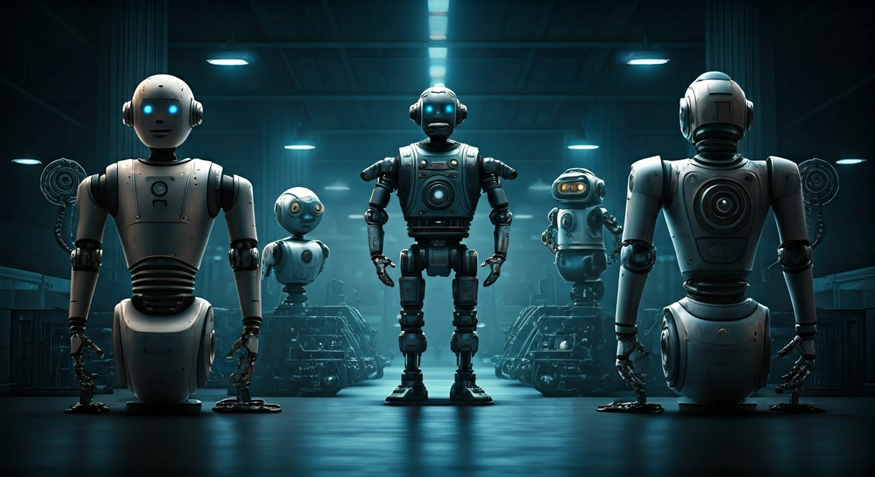
Today, many businesses use different robots to improve the way they work. Industrial robots are the most common in places like factories. These robots help with physical processes such as putting things together, welding, or packaging items. This makes sure the job is done fast and with high accuracy.
Collaborative robots, also known as cobots, help move automation further. They work with people in offices and on factory floors. Cobots are made to do repetitive tasks safely and quickly. These robots help people do more by working with them, not just by taking over.
Now, let's look at how industrial robots and collaborative robots help businesses automate more tasks each day.
Industrial Robots and Their Applications
Industrial robots are now very useful in automating many physical processes in different industries. These robots can do material handling, welding, assembly, and packaging jobs. They help businesses get more done with good accuracy and faster speed.
| Applications | Impact |
|---|---|
| Material Handling | Makes it easier to move goods, cuts costs, and uses less human intervention. |
| Assembly & Welding | Speeds up work with steady and correct welding and assembly for all kinds of products. |
| Inspection & Quality Control | Finds small problems faster than people, leading to better and more regularly quality of products. |
Industrial robotics is very important in the automotive, electronics, and logistics sectors. It helps businesses keep up with the growing need for products while making sure there is high quality every time.
Collaborative Robots (Cobots) in the Workplace
Collaboration between people and collaborative robots, or cobots, is changing how we work. It helps to make complex tasks easier and faster. Cobots use automation technology and machine learning to help us with jobs like material handling and customer service. They do not take away human judgment but instead work with us to make things run better.
These smart machines do many jobs over and over again. They cut down on human error and also lower tiredness from manual labor. By using business process automation, companies see better results in their work. Cobots make business process tasks smoother. This teamwork gives employees more time and helps them feel more satisfied at work. It also helps us focus on the parts of our jobs where people are needed the most.
Core Benefits of Robotic Automation for Businesses
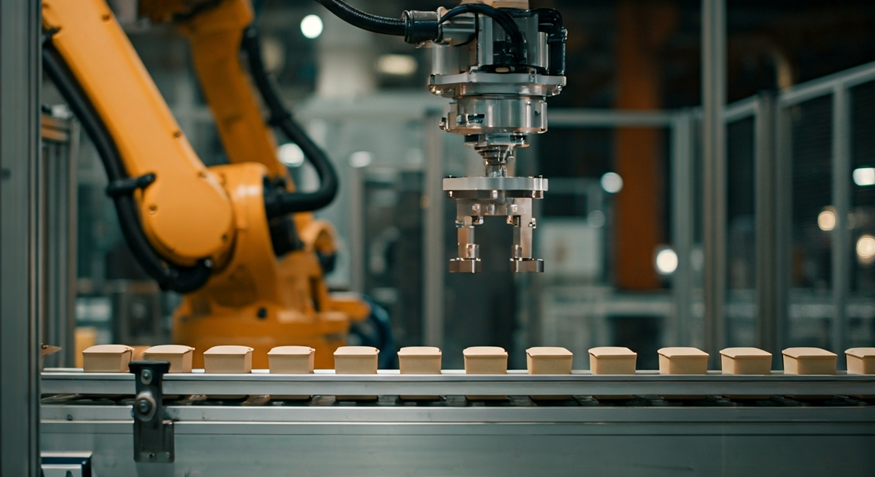
Robotic process automation gives a lot of benefits to the people in business. When the company uses software solutions for process automation, there is a drop in costs. It also helps the work get done in less time and with better results.
One good thing is that workers feel more satisfied. Robots can take care of tasks that are boring or the same every day. This lets workers spend their time on tasks that need more thought or skill. Robotic process automation also helps the company have less human error and get more work done. So, there is less time wasted, and people can trust the results more. Now, let’s look at how these benefits really help a business every day.
Efficiency, Productivity, and Cost Reduction
Automating workflows makes things much more smooth and quick. You can get the same or better work done in less time because robots are made to be very exact. They often do better than people with jobs you need to do over and over again. The results they give are also accurate, which helps you save both time and other resources.
There is less chance for problems to happen because robots do only what you tell them to do. They follow a set plan, so the results always come out the same, with no mistakes. This helps increase employee satisfaction, as people do not have to do boring or dull manual labor. Instead, they can use their brains in new ways and work on better ideas.
Business costs also go down because using process automation can let a company spend less on paying people. There will be fewer even bad items made. These clear upsides show why robotic process automation helps every business be better than others.
Enhanced Quality Control and Consistency
Keeping high quality for a business is very important. Robotic automation does this job very well. With process automation, robots can check work using smart image recognition.
Software robots that use computer vision can spot problems that people might miss. This helps get great results. Automating tasks means the job is the same every time. There is no change because someone is tired or makes a mistake. So, you can trust that the product will be good.
If you add automation software, you can check quality even better. This helps a business meet hard rules. In the end, robots make work more even, and this lets companies beat other businesses.
Real-World Use Cases of Robotic Automation
Robot automation is changing many industries, giving people solutions that fit their needs. In manufacturing, robots help with material handling and make production lines faster and smoother. They help companies work with more accuracy and speed.
In the service sector, robot automation takes care of repeating office jobs, answers customer questions, and handles other jobs by using RPA implementations. These examples show that robots help make work easier and help change old ways of working. Now, let’s look at how this changes both the manufacturing and service industries.
Manufacturing and Supply Chain Transformation
Manufacturing has changed a lot because of automation technology. Now, robots handle many material handling jobs like sorting, packaging, and moving things in supply chains.
Software automation helps factories work faster. It lets them make more goods all the time. Companies that use these automated systems see fewer problems and use their resources better.
All of this change makes it easier for goods to move around. Things go faster and mistakes happen less. Robotics lets businesses keep up with what people want. At the same time, they can make sure each product stays at a good quality, both in manufacturing and material handling.
Service Industry and Office Process Automation
Robotic automation is changing how offices work and how people get helped in customer-facing jobs. Here’s how:
- Customer Service: RPA bots handle chats and phone calls. They quickly answer client questions in online spaces.
- Data Management: Software robots do repetitive tasks like typing in data. This lessens the load on workers and gives them more time for other work.
- Scheduling: Automated systems set up appointments and stop double-booking. This makes things work better.
- Inventory Tracking: With process automation, stock levels update in real time. This helps people keep track and use resources better.
Using process automation like this with software robots lets the service industry offer better customer service and smoother work every day.
Conclusion
In the end, robotic automation is not just something new. It is a big change that is changing how many businesses work. When companies use robots in their work, they can do things faster. They can also save money and make sure things are made well. This means customers get better service. Robotic systems are very useful. You can see industrial robots in factories, and collaborative robots help people in other jobs. Both kinds show how this technology can be used in many ways. As more companies start to use robots, they will find new ways to grow and try new ideas. If you want to know what robotic automation can do for your business, you can ask for a meeting and find out more.
Frequently Asked Questions
How do robots differ from traditional automation systems?
Robots are not the same as old automation systems. While both use programmable machines, robots stand out in the automation process because they can make choices a bit like people do. Traditional automation does the same job over and over, with little change. But robots use smart software to watch what’s around them and match their actions to the situation as they work.
Are robots replacing human jobs or creating new roles?
Robots do not always take over what people do. Instead, they help with the work that has to be done again and again. This lets people spend their time on new ideas and creative work. The use of robots makes new jobs. There are now more chances for people to work on keeping these robots running and setting them up. This helps with employee satisfaction and gives people more ways to grow their work life.
What industries benefit the most from robotic automation?
Industries such as financial services, healthcare with medical records, and manufacturing do well when they use robotic automation. In the world of production, robots help people get more work done and are more accurate. Fields like logistics and customer service have seen big changes by using RPA bots and tools for virtual task automation.
What are the main challenges businesses face when adopting robots?
The main challenges here are the high cost to get started, and at first, employees may not want to use new RPA software. There is also a learning curve for people when they begin to use this process automation. Companies have to deal with the complex task of adding robots into their work without making things harder. They also need to make sure there is less human error when automating steps. The best way to get over these problems is with a careful plan.
How can small businesses start leveraging robotic automation?
Small businesses can start with cost-effective software solutions like robotic process automation. By using process mining tools, they can find areas that need process automation. Adopting forms of RPA that fit their needs helps these small businesses automate workflows in an easy and low-cost way.

